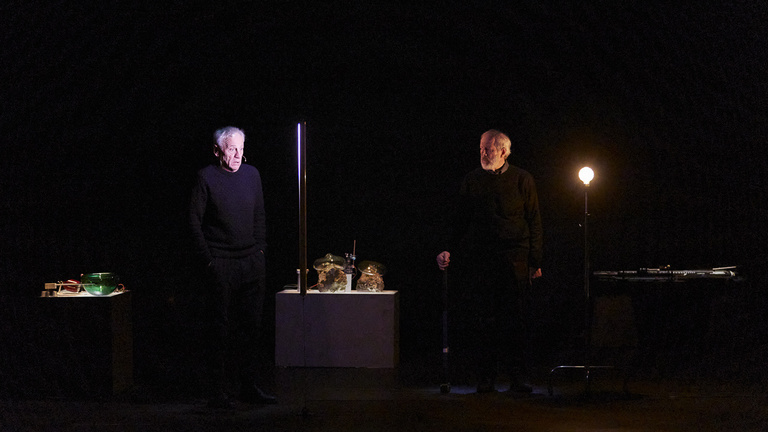
Intentions
Note of intent
by Jacques Osinski, stage director
There's something Shakespearean about Words and Music. A boneless Shakespeare, if I dare say so. I can't say exactly why, but the work reminds me of The Tempest, probably because like Shakespeare's play - and like all the plays I love - it can be read as a journey into the brain, the quest for a shattered, torn “self”. Propsero (the magician), Caliban (the earth) and Ariel (the spirit) are ludicrously and grotesquely answered by Croak (the old man in slippers), Bob (music) and Joe (words). Croak is the king of an imaginary, derisory empire, the “tower” he fleetingly evokes - the “castle” of which Pedro García Velasquez dreams. “Be friends,” he orders Words and Music, Joe and Bob. But, like Shakespearean servants, Bob and Joe don't care. Paroles can't stand Musique: "Please! (Orchestra. Louder.) Please! (Orchestra fades, falls silent.) How much longer will we have to rot here in the dark? (With disgust.) With you!". I love this prosaic confrontation between words and music. For words, music is noise. For music, words are useless... And yet, they must be brought together: that is the essence of art, the essence of opera. Beckett adds another challenge to this confrontation: it takes place in the dark.
Words and Music was written for radio. Originally, there was no audience for it, just listeners. So how do you represent it? I wanted to start from the reality of this blackness, from Joe's repugnance and fear at finding himself locked up in the dark with Bob. Out pops Croak, the human, their pathetic master.
Then, as in a fairytale, Pedro Garcia Velasquez's musical objects and robots come to life. Words and music come to life to the rhythm of the old man Croak's slipper movements. Light is born. Beckett may struggle against hope, against the dream, but it is always there: in the briefly evoked face of Lily, in the movement that animates Croak and sets Words and Music in motion. On stage, there is no set but the ghostly, heady presence of Pedro Garcia Velasquez's musical robots, the musicians' bodies to embody the music, and two fleshy, magnetic presences: those of Jan Hammenecker as Croak and Johan Leysen as the Lyrics.
We are in a fairytale castle, long forgotten and rediscovered like Sleeping Beauty's prince. We're in a music box. It spins, empty perhaps, like all music boxes. But it turns all the same, just as the earth turns. We never tire of looking at it. And in the sadness of Beckett's words, assembled as if for nothing, music and beauty emerge.